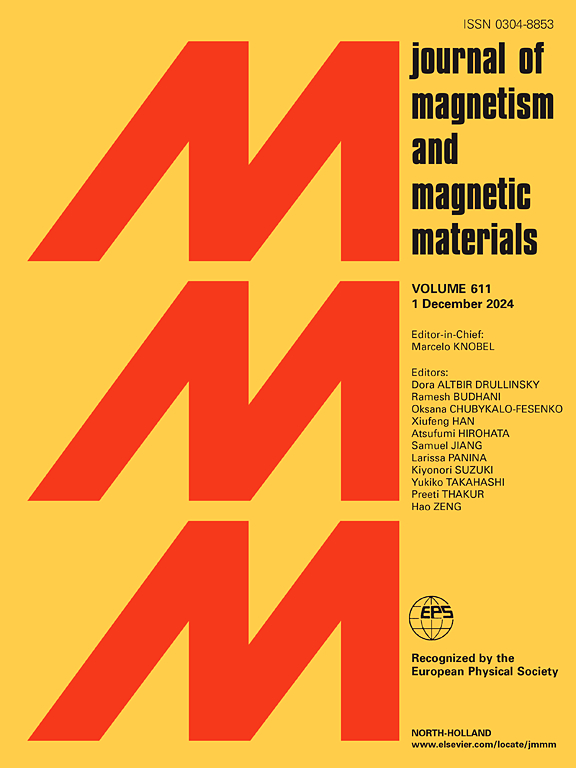Ni-Co-Mn-Sb-Cu Heusler合金中Cu掺杂增强磁热效应
IF 2.5
3区 材料科学
Q3 MATERIALS SCIENCE, MULTIDISCIPLINARY
引用次数: 0
摘要
室温磁制冷因其高能效和低环境影响而备受青睐。然而,需要进一步研究探索具有高磁热效应的低成本工作材料。本研究通过在Ni-Co-Mn-Sb超磁形状记忆合金中掺杂Cu来调节合金的磁结构转变参数,增强合金的磁热效应。Cu掺杂增加了相变熵变,有效调节了相变宽度,控制了相变温度对磁场的依赖性。在高相变熵变(35 J/kgK)、适当的相变温度依赖(−1.4 K/T)和窄相变宽度(13 K)的共同作用下,Ni41Co9Mn38Sb11Cu1合金在5 T磁场下表现出22.7 J/kgK的等温熵变和−4.1 K的高模拟绝热温度变化。本文章由计算机程序翻译,如有差异,请以英文原文为准。
Enhanced magnetocaloric effect via Cu doping in Ni-Co-Mn-Sb-Cu Heusler alloys
Room-temperature magnetic refrigeration is desirable owing to its high energy efficiency and low environmental effects. However, further research into exploring low-cost working materials with high magnetocaloric effects is required. In this study, Cu doping is employed in Ni-Co-Mn-Sb meta-magnetic shape memory alloys to tune the magnetostructural transformation parameters and enhance the magnetocaloric effect. Cu doping increases the transformation entropy change, effectively regulates the transformation width, and controls the magnetic field dependence of transformation temperature. Under the combined effect of a high transformation entropy change (35 J/kgK), an appropriate magnetic field dependence of transformation temperature (−1.4 K/T) and a narrow transformation width (13 K), Ni41Co9Mn38Sb11Cu1 alloys exhibit a large isothermal entropy change of 22.7 J/kgK and a high simulated adiabatic temperature change of −4.1 K in a magnetic field of 5 T.
求助全文
通过发布文献求助,成功后即可免费获取论文全文。
去求助
来源期刊

Journal of Magnetism and Magnetic Materials
物理-材料科学:综合
CiteScore
5.30
自引率
11.10%
发文量
1149
审稿时长
59 days
期刊介绍:
The Journal of Magnetism and Magnetic Materials provides an important forum for the disclosure and discussion of original contributions covering the whole spectrum of topics, from basic magnetism to the technology and applications of magnetic materials. The journal encourages greater interaction between the basic and applied sub-disciplines of magnetism with comprehensive review articles, in addition to full-length contributions. In addition, other categories of contributions are welcome, including Critical Focused issues, Current Perspectives and Outreach to the General Public.
Main Categories:
Full-length articles:
Technically original research documents that report results of value to the communities that comprise the journal audience. The link between chemical, structural and microstructural properties on the one hand and magnetic properties on the other hand are encouraged.
In addition to general topics covering all areas of magnetism and magnetic materials, the full-length articles also include three sub-sections, focusing on Nanomagnetism, Spintronics and Applications.
The sub-section on Nanomagnetism contains articles on magnetic nanoparticles, nanowires, thin films, 2D materials and other nanoscale magnetic materials and their applications.
The sub-section on Spintronics contains articles on magnetoresistance, magnetoimpedance, magneto-optical phenomena, Micro-Electro-Mechanical Systems (MEMS), and other topics related to spin current control and magneto-transport phenomena. The sub-section on Applications display papers that focus on applications of magnetic materials. The applications need to show a connection to magnetism.
Review articles:
Review articles organize, clarify, and summarize existing major works in the areas covered by the Journal and provide comprehensive citations to the full spectrum of relevant literature.
 求助内容:
求助内容: 应助结果提醒方式:
应助结果提醒方式:


